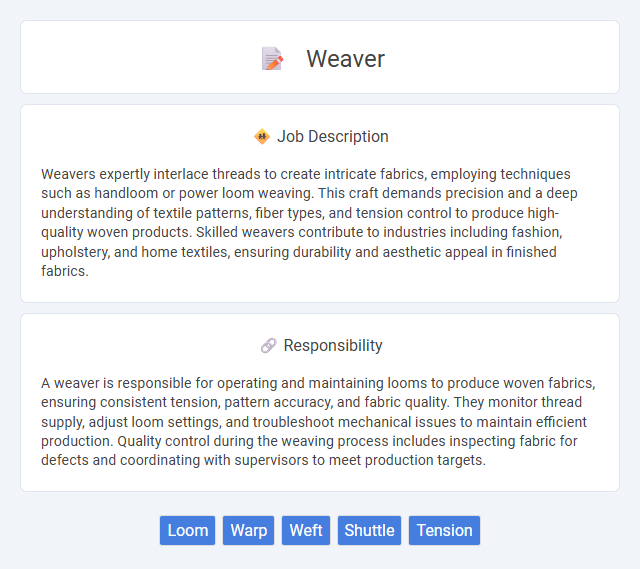
Weavers expertly interlace threads to create intricate fabrics, employing techniques such as handloom or power loom weaving. This craft demands precision and a deep understanding of textile patterns, fiber types, and tension control to produce high-quality woven products. Skilled weavers contribute to industries including fashion, upholstery, and home textiles, ensuring durability and aesthetic appeal in finished fabrics.
People with strong manual dexterity and attention to detail are likely to succeed as weavers, as the job requires precise hand-eye coordination and patience. Individuals who are comfortable working in repetitive environments and can maintain focus for extended periods may find weaving suitable. Those with physical conditions that affect fine motor skills or stamina might face challenges in this role.
Qualification
Weaver job qualifications typically include proficiency in operating handlooms or power looms with a strong understanding of textile patterns and materials. Candidates should have experience in fabric inspection, attention to detail, and the ability to maintain consistent tension and speed during weaving. Basic knowledge of textile machinery maintenance and safety standards is often required to ensure high-quality fabric production.
Responsibility
A weaver is responsible for operating and maintaining looms to produce woven fabrics, ensuring consistent tension, pattern accuracy, and fabric quality. They monitor thread supply, adjust loom settings, and troubleshoot mechanical issues to maintain efficient production. Quality control during the weaving process includes inspecting fabric for defects and coordinating with supervisors to meet production targets.
Benefit
Weaving jobs likely provide substantial benefits such as enhancing fine motor skills and fostering creativity through pattern design. The role might offer steady employment opportunities in textile industries, contributing to financial stability. Workers could also experience satisfaction from producing tangible, high-quality fabric products that support various fashion and home decor markets.
Challenge
Working as a weaver likely involves navigating complex patterns and maintaining precision to ensure fabric quality, which can present significant challenges. Mastering technical skills and adapting to evolving textile technologies may require continuous learning and problem-solving. The probability of encountering tight deadlines and high production standards suggests a demanding but rewarding work environment.
Career Advancement
Weaver career advancement involves mastering complex weaving techniques and gaining expertise in textile design software to increase employability. Progression often leads to supervisory roles or quality control positions within textile manufacturing plants. Continuous skill development and industry certifications significantly enhance promotion opportunities in this field.
Key Terms
Loom
Weavers operate looms to interlace threads, creating fabric with precision and consistency. Modern industrial looms enhance weaving speed and fabric quality through automated controls and advanced tension regulation. Mastery of loom mechanics and pattern programming ensures efficient textile production across various materials and designs.
Warp
A weaver meticulously arranges the warp threads, which run lengthwise on the loom, to create the fabric's foundational structure. The tension and spacing of the warp threads directly influence the strength, texture, and pattern of the woven material. Mastery in controlling warp alignment ensures high-quality textiles in industries ranging from fashion to upholstery.
Weft
Weavers skillfully interlace weft threads horizontally across the warp to create fabric patterns and textures with precision. The tension and placement of the weft determine the strength and design intricacy of the woven material. Mastery in controlling weft insertion speed and consistency is essential for producing high-quality textiles in various weaving techniques.
Shuttle
A weaver operating a shuttle loom expertly interlaces warp and weft threads to create dense, uniform fabric with consistent texture. The shuttle, a key component in traditional weaving, carries the weft yarn back and forth through the warp threads, enabling precise control over fabric tension and pattern complexity. Mastery of shuttle weaving ensures high-quality textile production suitable for intricate designs and durable materials.
Tension
Maintaining precise tension is critical in weaving to ensure consistent fabric quality and prevent defects like distortion or uneven texture. Proper tension control influences the alignment of warp and weft threads, impacting the durability and appearance of the woven material. Advanced weaving machines incorporate tension sensors and automatic adjustments to optimize thread tension for various fabric types.
 kuljobs.com
kuljobs.com